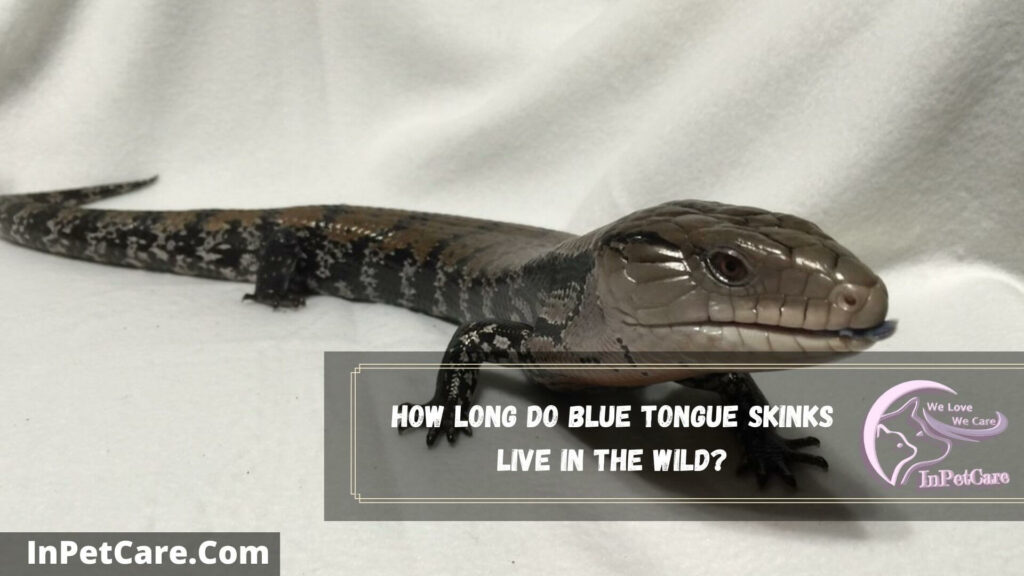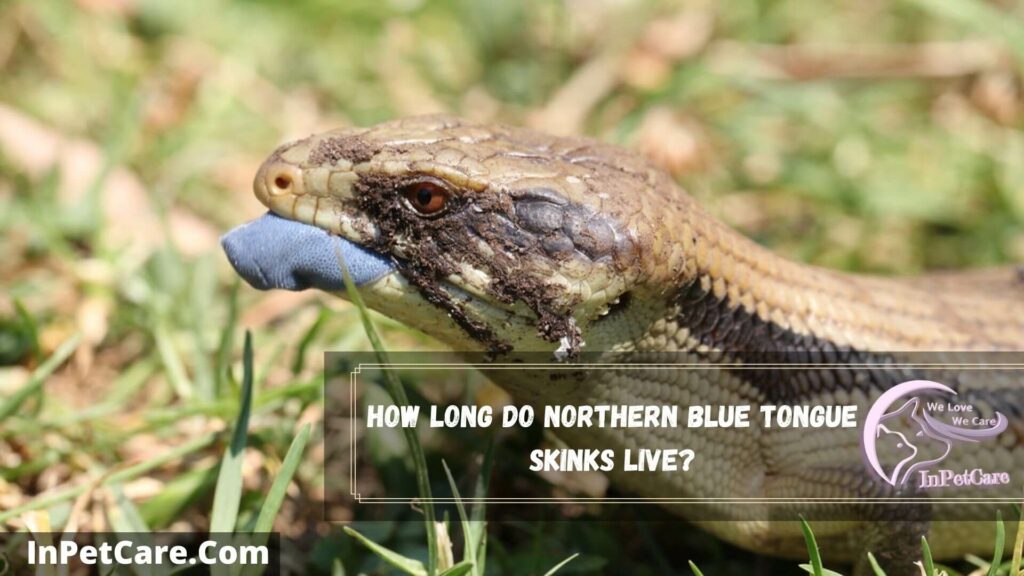Most of the lizard owners and skink owners make several mistakes that can reduce their skink’s lifespan. In this article, we will discuss blue tongue skink species lifespan in captivity and the wild. You will learn how long do blue tongue skinks live? Along with how to increase the lifespan of a skink. Before that, let’s know the average life expectancy of blue tongue skink species.
Post Contents
How Long Do Blue Tongue Skinks Live In The Wild?

In the wild, blue tongue skink can live up to 7 to 12 years. This is because of their natural predators and scarcity of food. Birds like hawks, eagles, and vultures primarily feed on blue tongue skink. A skink can also be hunted down by big cats, wolves, and foxes.
When they are attacked in the wild and left with serious injury, they usually suffer from being too lazy and unable to prey. Getting killed or seriously wounded when attacked severely shortens its population’s average lifespan.
Other than food scarcity, droughts can also make their survival more difficult. Skinks need to be dehydrated for proper growth, shedding, and wellbeing. We can say that the combination of food scarcity, droughts, and predation of skinks reduces their life expectancy by at least 6 to 8 years. An insect bite can also release parasites in blue tongue skink skin, which gradually leads to infections and diseases.
How Long Do Blue Tongue Skinks Live In Captivity?
Blue tongue skink can live up to 15 years to 20 years in captivity with proper care. Male skinks tend to live longer than females due to fertility. Getting a bigger blue tongue skink would be better and more durable as it can withstand harsh environmental conditions also.
Prominent individuals also can accommodate accordingly inside the enclosure if the temperature suddenly drops or humidity increases than needed. The female blue tongue skink has to give birth which takes a significant toll on her body. Such energy expenditure in female skinks reduces her lifespan.
7 Factors That Impact Blue Tongue Skink Lifespan In Captivity
Multiple factors can impact your stink lifespan in the enclosure. Proper husbandry and care are needed to increase the lifespan. Let’s learn the unfortunate mistakes that you can make and reduce your skink life as well. Following are the mistakes made by owners that reduced their skink lifespan.
- Feeding an adult Skink with lots of protein.
- Not giving enough plant matter and nutrients.
- Poor temperature and humidity gradient in their enclosure for too long.
- Not maintaining the proper humidity levels, light, UVB temperature, and heat.
- You forgot to monitor their poop.
- Breeding a too young female skink
- Keeping skin in a tank that is too small for them to thrive.
After knowing the mistakes you need to avoid, let’s learn how to go through each error and make corrections.
How To Increase Blue Tongue Skinks Lifespan?
Following are the essential tips to help you increase your lifespan.
Diet
You need to provide them with a well-balanced diet according to their age which supports their health, wellbeing, and growth. When your skink is juvenile, you need to feed them more protein-based content and diet. Consider providing them with more insects. At the same time, adult skinks should be fed more plant matter and vegetables based diet.
An adult blue tongue skink should consist of 50% green (veggies, leaves & plant matter), 40% insects/animals-based protein, and 10% fruits mix. Be sure you are not feeding them with a diet that has too many oxalates; otherwise, it can interfere with calcium absorption. Here you can learn what fruits can blue tongue skinks eat.
It would help if you fed more calcium and protein to young ones. However, too much calcium can lead to health issues as well. Avoid feeling too much Phosphorus as it can also interfere with calcium absorption. It is a good idea to feed calcium carbonate supplements to your blue tongue skink twice weekly.
Breeding
If you are looking to increase your female life expectancy, then consider not breeding her. Breeding will reduce her lifespan as it results in an abdomen’s considerable enlargement and loss of mass. It drains her energy as well. The energy expended during the reproduction and giving birth to young ones also have a significant effect. They don’t usually lay eggs like other lizards. If you are still choosing to breed your skink, consider giving time to help her recover.
Monitor Its Poop
It is vital to monitor your blue tongue skinks’ poop because it can tell too many things about their health. It is one of the best ways to monitor their immune system, common dietary mistakes, and health. I have shared a detailed guide on skink poop where you can learn about its annoying smell, unusual color, runny poop, and more.
Monitor Their Movement And Body Structure
It is always best to monitor your skink movements and body structure. Any deformation in their spine, frontal legs, or jaws will be visible as it progresses. Metabolic bone disease is one of the most common health issues for this species. It usually targets the function of your skink bones rather than being infectious. Lack of UV light or calcium can lead to metallic bone diseases.
Enclosure
It is very vital to pay close attention to the temperature gradient and humidity level of tank’s each side. The ideal temperature for your skink ranges from 75°-80° F on the cooler end of the tank and 80-85° on the warmer end. Remember to provide a shaded area also to cool down for them. They need at least a 60 gallon-sized tank with the proper level of humidity, heat, light, and substrate to thrive.
Missing any of these will decrease their lifespan while contributing to diseases, infections & health problems. Check the substrate because sometimes your pet skink can ingest its particles leading to a severe health issue. I will recommend you always use non-particle substrates. Install two hygrometers on both ends of the tank to get the correct reading. Keeping them in a tiny enclosure will increase the stress level and negative impact on their health.
Species
There are many species of Blue Tongue Skinks. The largest subspecies of blue tongue skink In The wild tend to be more resilient than the smaller ones. It is due to being more prominent and better at fending off the predators and adapting to environmental changes. Let’s learn about the lifespan of different Blue Tongue Skink species.
How Long Do Northern Blue Tongue Skinks Live?

In the Wild, Northern blue tongue skink tends to live upto 8-12 years, while in captivity, they can live up to 15 years with proper care and guidance. Being so friendly, you can always adopt them and keep them as pets. They are effortless to acclimate in captivity, but the tank should be more than 55 gallons.
How Long Do Indonesian Blue Tongue Skinks Live?
Indonesian blue tongue skink can live up to 12 years In The wild and 20-30 years in captivity. Although they can live up to 30 years in captivity, it requires good care. They are not very social reptiles but still can be kept as pets. The expected size of an Indonesian blue tongue skink is between 15-30 inches. Indonesian blue tongue skinks are considered a vulnerable species, while Pygmy blue tongue skinks are endangered.
How Long Do Eastern Blue Tongue Lizards Live For?
Eastern blue tongue lizards live up to 15 years in the wild while live up to 20 years with managed care. On excellent care, we have seen exceptional individuals passing over 30 years in age. They usually have thick sausage-like bodies with solid limbs and triangular heads. It is essential to give them a large-sized tank and lighting.
FAQ
- Best Substrate For Blue Tongue Skinks
- All You Need To Know About What Can Blue Tongue Skinks Eat?
- Does Petsmart or Petco Sell Blue Tongue Skinks?
Do Blue Tongue Skinks Make Good Pets?
Blue tongue skinks make excellent pets as they are easy to care for, need low maintenance, and are great for children. They are good beginner pets to have but only when you are prepared with the relatively large-sized tank. These skinks tend to be somewhat more prominent compared to their other subspecies. They can also be hand tamed and likes to be handed if appropriately managed. Their popularity and acceptance as pets have been increasing over the last five years and will continue so.
Where Do Blue Tongue Skinks Live?
Blue tongue skink lives in the mainland of Australia and is widely spread in New Guinea. You can find them throughout northwest Australia in coastal areas with a less arid climate. They prefer living on grounds with lots of cover and mulch to shelter and hide from predators easily.
They are also available in Tasmania and inhabit semi-deserts. Most of the eastern blue tongue skinks are found in the southeastern and northern parts of Australia. At the same time, Western blue tongue skinks are scarce species and usually not kept as pets as its other subspecies.

94% of pet owners say their animal pal makes them smile more than once a day. In 2007, I realized that I was made for saving Animals. My father is a Vet, and I think every pet deserves one. I started this blog, “InPetCare”, in 2019 with my father to enlighten a wider audience.
